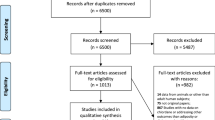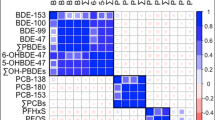Abstract
There is emerging evidence that persistent organic pollutants (POPs) can increase the risk of various chronic diseases. As POPs mainly bioaccumulate in adipose tissue, weight change can affect serum concentrations of POPs. However, there are few population-based studies on effects of long-term weight change on serum concentrations of POPs. We examined associations between self-reported weight change over 1 year and 10 years and serum concentrations of seven POPs in 1099 adults aged ⩾40. Serum concentrations of most POPs were higher in those with long-term weight loss, whereas they were lower in those with long-term weight gain. Adjusted correlation coefficients of each POP with weight change for 10 years were −0.23 (P<0.01) for trans-nonachlor, −0.16 (P<0.01) for p,p′-dichlorodiphenyldichloroethylene, and −0.21 (P<0.01) for β-hexachlorocyclohexane, −0.16 (P<0.01) for PCB169, −0.20 (P<0.01) for PCB180 and −0.17 (P<0.01) for 1,2,3,4,6,7,8-heptachlorodibenzo-p-dioxin. Weight change for 1 year showed similar but weaker associations, compared with those of long-term weight changes. Although both beneficial health effects after weight loss and harmful health effects after weight gain are generally expected, changes in serum concentrations of POPs in relation to weight change may act on health in directions opposite to what we expect with weight change.
This is a preview of subscription content, access via your institution
Access options
Subscribe to this journal
Receive 12 print issues and online access
$259.00 per year
only $21.58 per issue
Buy this article
- Purchase on Springer Link
- Instant access to full article PDF
Prices may be subject to local taxes which are calculated during checkout

Similar content being viewed by others
References
Lee DH, Lee IK, Song K, Steffes M, Toscano W, Baker BA et al. A strong dose-response relation between serum concentrations of persistent organic pollutants and diabetes: results from the National Health and Examination Survey 1999-2002. Diabetes Care 2006; 29: 1638–1644.
Ha MH, Lee DH, Jacobs DR . Association between serum concentrations of persistent organic pollutants and self-reported cardiovascular disease prevalence: results from the National Health and Nutrition Examination Survey, 1999-2002. Environ Health Perspect 2007; 115: 1204–1209.
Chevrier J, Dewailly E, Ayotte P, Mauriege P, Despres JP, Tremblay A . Body weight loss increases plasma and adipose tissue concentrations of potentially toxic pollutants in obese individuals. Int J Obes Relat Metab Disord 2000; 24: 1272–1278.
Hue O, Marcotte J, Berrigan F, Simoneau M, Dore J, Marceau P et al. Increased plasma levels of toxic pollutants accompanying weight loss induced by hypocaloric diet or by bariatric surgery. Obes Surg 2006; 16: 1145–1154.
Imbeault P, Chevrier J, Dewailly E, Ayotte P, Despres JP, Tremblay A et al. Increase in plasma pollutant levels in response to weight loss in humans is related to in vitro subcutaneous adipocyte basal lipolysis. Int J Obes Relat Metab Disord 2001; 25: 1585–1591.
Korn EL, Graubard BI . Epidemiologic studies utilizing surveys: accounting for the sampling design. Am J Public Health 1991; 81: 1166–1173.
Graubard BI, Korn EL . Analyzing health surveys for cancer-related objectives. J Natl Cancer Inst 1999; 91: 1005–1016.
Tamakoshi K, Yatsuya H, Kondo T, Hirano T, Hori Y, Yoshida T et al. The accuracy of long-term recall of past body weight in Japanese adult men. Int J Obes Relat Metab Disord 2003; 27: 247–252.
Droyvold WB, Lund Nilsen TI, Lydersen S, Midthjell K, Nilsson PM, Nilsson JA et al. Weight change and mortality: the Nord-Trondelag Health Study. J Intern Med 2005; 257: 338–345.
Hughes TF, Borenstein AR, Schofield E, Wu Y, Larson EB . Association between late-life body mass index and dementia: The Kame Project. Neurology 2009; 72: 1741–1746.
Maru S, van der Schouw YT, Gimbrere CH, Grobbee DE, Peeters PH . Body mass index and short-term weight change in relation to mortality in Dutch women after age 50 y. Am J Clin Nutr 2004; 80: 231–236.
Rosengren A, Wedel H, Wilhelmsen L . Body weight and weight gain during adult life in men in relation to coronary heart disease and mortality. A prospective population study. Eur Heart J 1999; 20: 269–277.
Sorensen TI, Rissanen A, Korkeila M, Kaprio J . Intention to lose weight, weight changes, and 18-y mortality in overweight individuals without co-morbidities. PLoS Med 2005; 2: e171.
Yarnell JW, Patterson CC, Thomas HF, Sweetnam PM . Comparison of weight in middle age, weight at 18 years, and weight change between, in predicting subsequent 14 year mortality and coronary events: Caerphilly Prospective Study. J Epidemiol Community Health 2000; 54: 344–348.
Astrup A . Weight loss and increased mortality: epidemiologists blinded by observations? Obes Rev 2003; 4: 1–2.
Stampfer M . Weight loss and mortality: what does the evidence show? PLoS Med 2005; 2: e181.
Author information
Authors and Affiliations
Corresponding author
Ethics declarations
Competing interests
The authors declare no conflict of interest.
Rights and permissions
About this article
Cite this article
Lim, J., Son, HK., Park, SK. et al. Inverse associations between long-term weight change and serum concentrations of persistent organic pollutants. Int J Obes 35, 744–747 (2011). https://doi.org/10.1038/ijo.2010.188
Received:
Revised:
Accepted:
Published:
Issue Date:
DOI: https://doi.org/10.1038/ijo.2010.188
Keywords
This article is cited by
-
Polychlorinated biphenyls and risk of hepatocellular carcinoma in the population living in a highly polluted area in Italy
Scientific Reports (2021)
-
Predictors of Beta-Hexachlorocyclohexane blood levels among people living close to a chemical plant and an illegal dumping site
Environmental Health (2020)
-
Persistent organic pollutants and non-alcoholic fatty liver disease in morbidly obese patients: a cohort study
Environmental Health (2015)
-
Methodological issues in human studies of endocrine disrupting chemicals
Reviews in Endocrine and Metabolic Disorders (2015)
-
Gray and white matter structures in the midcingulate cortex region contribute to body mass index in Chinese young adults
Brain Structure and Function (2015)



